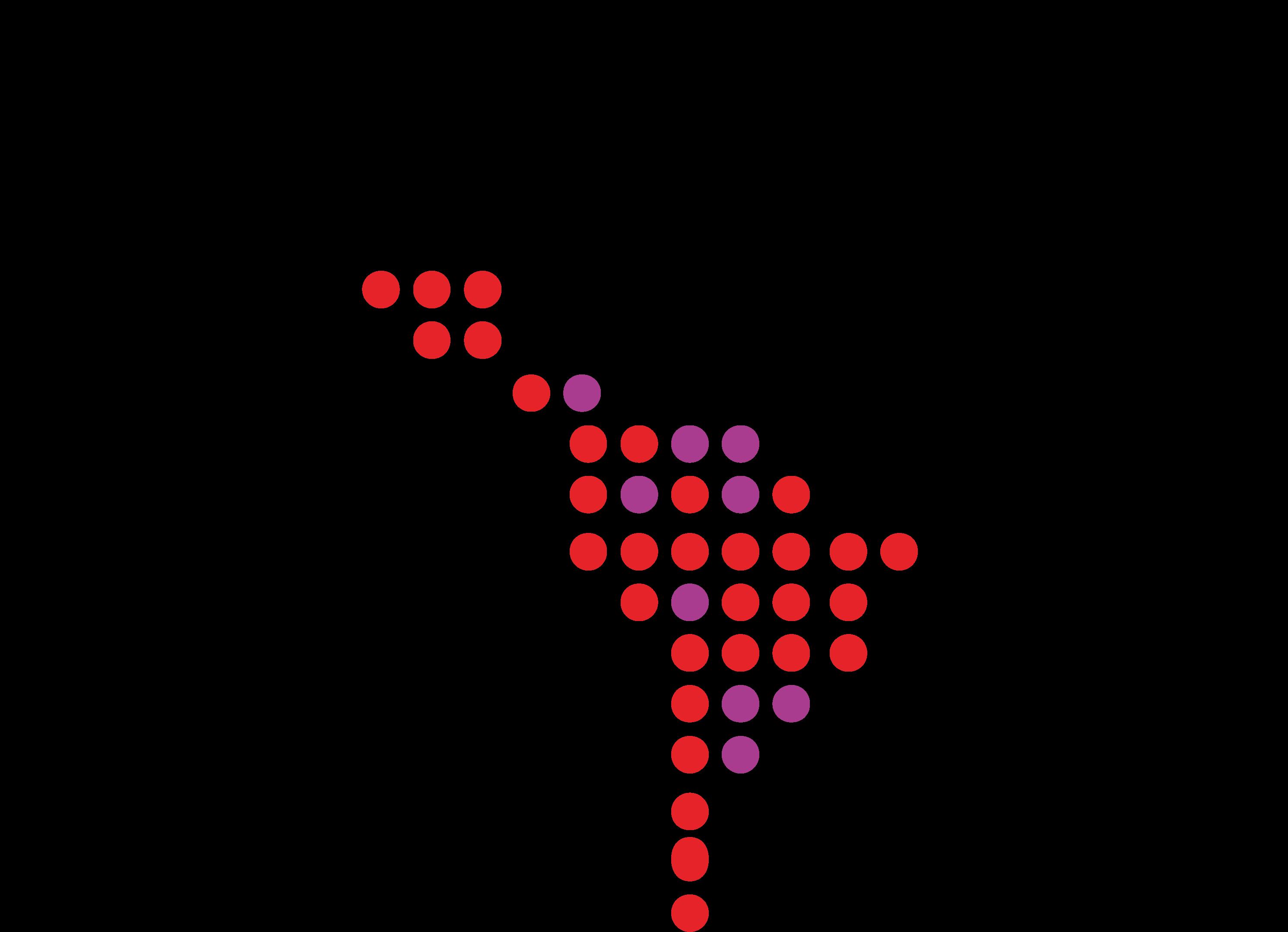
















































nuvei.com
At Nuvei, we have long believed in the power and potential of connections to accelerate the business of our customers and partners worldwide.
At our core, we help our clients to connect with theirs by enabling seamless pay-in and payout capabilities, locally and globally, in over 200 markets worldwide. Today, we are a leader in terms of global payment coverage, with more than 600 payment methods and local acquiring in over 47 markets, in nearly 150 currencies, and the consumers’ choice of language at every given moment, device, or location.
With this in mind, we developed this report to provide timely insights into the connections between European and Latin American markets. Many of our clients are interested in eCommerce payment trends and growth drivers; shining a spotlight on such important, rapidly evolving markets ultimately helps businesses make better decisions.
This study marks the second in a series of reports we will produce, exploring opportunities for growth across different regions. We look forward to sharing our insights and working with our merchants to take advantage of emerging opportunities.


Longstanding collaborations between Latin America and Europe provide a commercial bridge while reinforcing cultural ties
The relationship between Europe and Latin America is steeped in powerful cultural, linguistic, and economic bonds. Over 13 million European immigrants moved to Latin America during the wars of the 20th century1 and today, nearly 100% of Latin America speaks Spanish and Portuguese. From their love of football to culinary similarities and religious affinities, the two regions are among the world’s most closely aligned in terms of interests, language, and culture.
1. Cambridge University Press
Latin America represents an excellent source for Europe, as it exports raw materials— minerals, agricultural products, and energy— and European industry generates value-added goods. In 2021, 85% of the exports from the EU to Brazil were manufactured goods, whereas 77% of imports from Brazil were primary goods. Peru, Chile, and Colombia follow the same trade pattern. In 2021, trade between the two regions totaled USD$233 billion in goods and USD$113 billion in
services, or 5% and 6%, respectively, of the total EU trade. Mexico and Brazil together are responsible for 25% and 31%, respectively, of the trade in Latin America and the Caribbean. Respectively, they also rank 11th and 13th worldwide as the largest partners for EU exports and are the 17th and 13th largest partners in imports.2 2.


3.
4.
5.
The European Union is also Latin America’s largest foreign direct investor, infusing the region with USD$37 billion in 2021. Renewable energy, cars and auto parts, and technologyintensive industries were the leading sectors targeted for investments, continuing the historical trend of Europe bringing technology and innovation to the region.3 European giants have helped build Latin America’s telecommunications infrastructure, such as 5G development, and include Nokia (Finland), Ericsson (Sweden), Telefónica (Spain), Millicom (Sweden), Deutsche Telekom (Germany), Orange (France), and TIM (Italy).
Perhaps the most significant recent development is the resurgence of the EUMercosur economic deal: after 24 years of negotiation, the Mercosur free trade economic deal is closer than ever to being finalized, thanks to the rising political pink tide, with left-leaning leaders in Mexico, Argentina, Brazil, Bolivia, Peru, Chile, and Colombia. Arrangements are being made between the EU and the Community of Latin America and Caribbean States (CELAC) to host a summit meeting in Brussels to discuss this matter. As stated by Josep Borrel, EU foreign affairs representative, 2023 will be “The Year of Latin America in Europe” and “The Year of Europe in Latin America.”4 5
Europe has also heavily influenced Latin America in banking and finance. Spanish banks Santander and BBVA are regional banking giants, both with a presence across Mexico, Brazil, Colombia, Peru, Chile, and Argentina. More recently, leading European neobanks, including Revolut, N26, PaySafe, and PaySend, are making a move for Latin America, leveraging some of the structural
similarities between the two regions, such as language, regional fragmentation, and affinity for alternative payment methods.
Even more relevant, Latin America has looked to Europe for guidance in financial industry regulation. Europe has been a world leader in regulations around data protection and open banking. The 2019 Payment Services Directive 2 (PSD2) accelerated the adoption of 3DSecure, the industry standard security protocol for card transactions, which in turn has increased data sharing between acquirers and issuers and introduced biometric authentication. This directive has also paved the way for open banking, a model which has been fully embraced by Brazil, Latin America’s open banking pioneer. As Latin American banking has traditionally operated in silos—bank oligopolies locking up consumer data—Brazil’s Eurocentric approach to open banking seeks to fully democratize access to consumer data, create an API-based approach to finance, and speed up money movement and financial inclusion.
While Latin America is certainly its own animal—with more than 30 jurisdictions, huge cultural diversity, unique economic and political structures, and strong influence from North America—the region is strongly reminiscent of Spain, Portugal, Italy, and Britain, with enclaves of German, Scandinavian, and Eastern European influence. This creates a natural cultural alignment and business corridors, which become even more prominent in the digital age.
Considering these synergies, Latin America represents major growth opportunities for European companies across manufacturing, telecom, energy, retail, finance, and eCommerce. Observing the fintech and banking connections and similarities, European merchants have a large and untapped opportunity in eCommerce, especially considering Europe’s own payments and eCommerce context.
First, it is important to understand the European eCommerce industry’s own growth. In 2019, online payments for non-recurring purchases represented only 6% of all transactions in Europe (in-store and eCommerce), with the UK and France ahead and Spain and Portugal far below this average. Today, in 2023, this penetration has jumped nearly threefold to 17% (share of transactions) and 28% (share of volume).6

This rapid growth has been supported by merchants expanding their payment method offerings beyond cards. Europe is intrinsically a less card-heavy market than the US, with a high preference for cash in markets like Germany, and an overall aversion to using credit cards online due to fraud concerns. With the advance of open banking and bank account interoperability across Europe in recent years, 2022 saw alternative payment methods (APMs)—primarily wallets and bank transfers—overtake cards, representing 54% of the total value paid online in 2022 in Europe. In places like the Netherlands, APMs represented an impressive 90%, derived mainly from wallets like market-share leader
6.
iDeal direct debit (over 70%), PayPal, and Klarna BNPL solutions. Germany also stands out, with customers accustomed to bank transfers (over 50% of total online payments) and a low card culture; APMs represented nearly 80% of total online payments.7
Traditional cards (mainly debit) still show a market dominance in countries such as Portugal (48% share of eCommerce), Spain (58%), France (57%), and the United Kingdom (51%). Yet even in these markets, consumers have increased their awareness of non-card options, including direct payment, either directly between customer and merchant (open banking), or via direct debit or wallets (funded directly by debiting the customer’s bank account).8

Comparatively, succeeding in Latin America’s eCommerce environment requires the same level of understanding of payment method trends. Latin America is characterized by uneven digital account penetration, ranging from 65% in Peru to 72% in Mexico, 75% in Colombia, 81% in Brazil, and 90% in Chile and by an entire generation of recently digitized consumers who have not been exposed to credit card payments online. These consumers require a variety of alternative payment methods—from bank transfers to wallets to cash-based payments to point-of-sale lending—which are estimated to represent nearly 40% of total online payments in 2023 for the LatAm region.9
There is a huge untapped opportunity for European merchants to be successful in Latin America. PCMI estimates that the current cross-border share with European merchants in 2023 will be 2% of all of Latin America’s cross-border eCommerce, although it is currently growing more than 20% per year. That is an estimated USD$1 billion. Of this amount, 72% is Brazilian and 20% is Mexican crossborder spending with European merchants. This volume does not include the volume produced by European merchants that have already invested directly in the region and established local entities, such as large, successful retailers like Carrefour, Inditex, IKEA, and others. 7.

If European merchants start to actively target Latin American countries, the percentage growth could be much higher, especially since there are significant opportunities. A potentially lucrative segment for European merchants are the top earners in Latin America. The 1% with the highest income earns more than USD$241,000 per year; this group of over 5 million people wants to buy luxury differentiated products but must currently travel abroad to do so. European merchants can target this exclusive market. A broader target would be the top 10% of Latin Americans; these 46 million people make up the wealthiest population,10 those who can afford to buy exclusive brands and access the fashion lines of top designers.
Even though the Brazilian cross-border segment makes up only 6% of total eCommerce, due to the magnitude of the population, this is not only a significant market but also a latent opportunity. Winning in the Brazilian market requires not only credit cards, but also PIX, due to its growing relevance, which European luxury brands have understood and gradually incorporated into their acceptance methods. This is because not only are the traditional boleto users now using PIX, but the card holders also tend to value PIX as a safe option that enables them to buy online without using credit card numbers. In addition, stores offering discounts to those who pay with PIX provide an added incentive to use of this form of payment. In the remaining Latin American countries, it is key for merchants to incorporate the local payment methods to capture cross-border volume, which averages 14% across Latin America, since during online shopping, consumers’ local cards could be blocked by issuers due to security reasons. Mexico represents an important opportunity due to its current share of cross-border commerce; approximately a fourth of its volume can be attributed to non-local merchants. A similar share occurs in Chile and Peru, but because of its volume, Mexico could be prioritized as a market to target, followed by Chile due to its GDP per capita, one of the highest in Latin America.

Businesses in Europe already experience a dynamic alternative payment landscape, also present in Latin America. Other important leveraging aspects favor European companies in Latin America, including that Europeans can easily navigate Latin America’s two languages, both of which are spoken in Europe, and they have experience with the localization needed to succeed in individual markets.
l Aspirational brands and lack of local competitors: Latin Americans have always looked to Europe for more exclusive, sophisticated, and high-end products, while European brands are key for aspirational middle classes.
l There are natural business corridors between Portugal, Spain, France, Italy, Germany, and Latin America, due to historic relationships and immigration patterns.
l Brazil and Mexico are high-growth eCommerce markets with large populations and high income levels in the upper classes, and are under-stocked by the local supply.
On the next few pages, we will provide is a deep dive into Latin America’s largest markets, Brazil and Mexico, with insights about the key growth markets, such as Chile, Colombia, and Peru. The goal is to help European merchants to understand the opportunities in these markets, as well as the specific dynamics to navigate when approaching these economies. With the correct payment partner, European merchants can leverage their cultural similarities with Latin America and find niche opportunities among consumers who are ready to enjoy what European brands have to offer.
“From the outset we formed a true partnership with the Nuvei team. Their deep global payment expertise is complemented by their human approach to doing business and their desire to work with us to accelerate our business growth. We’re looking forward to taking our payment strategy to new heights by working with Nuvei.”
KELI SANDEMAN
















Brazil is Latin America’s behemoth, with a population of over 200 million; it is also responsible for 47% of Latin America’s eCommerce volume. It has also spearheaded innovation in Latin America, with impressive success stories such as Nubank, the world’s largest neobank, which made history with its free credit card, now expanding to Mexico. PIX, the Brazilian Central Bank’s rail for instant money transfers, scaled to 80% of Brazilians in just 24 months. PIX has revolutionized the way Brazilians make payments and is responsible for a projected USD$74 billion in eCommerce volume (28%) in 2023. Brazil is a fast-moving, competitive, and exciting eCommerce market that is fully prepared for international merchants offering novel products, as well as seamless, highly innovative payment experiences.
*PCMI, 2022. ECommerce Data Library.

The GDP per capita of Chile, the wealthiest country in the region, will exceed USD$16,000 in 2023, higher than Mexico and Brazil (USD$11,642 and USD$9,182, respectively). Chile has historically had one of the most stable currencies in Latin America, making it attractive for foreign investment. It also has an impressive banking penetration of 97%, largely thanks to Banco Estado, a state-owned bank that enables everyone with a local ID to have a debit card. Cards account for 74% of eCommerce, with a low comparative proportion of alternative payment methods. However, the eCommerce user experience has suffered, thanks to a historical monopoly in the acquirer business. This created an opportunity for international merchants to compete. Under regulatory pressure, Chile is now transitioning from a three-part to a four-part acquiring model, with new competition in the acquiring market currently emerging.

Colombia, the third most populous Latin American country, has turned out to be the king of wallets. To reduce money laundering, the Colombian government has promoted wallets, even well before the pandemic, as well as DaviPlata, Davivienda’s digital wallet, to send money to the families of members of the army. Not until the pandemic in 2020 did the government begin to use digital wallets to distribute subsidies to the population. This initiative was a catalyst for the digitization of the population, which is why today Colombia reigns supreme in wallet penetration at 76%.

Mexico has an impressive offering of payment methods, ranging from Central Bank rails such as SPEI to multiple wallets, to Buy Now Pay Later (BNPL), to credit and debit cards. Even so, cash continues to be the primary payment method and most eCommerce merchants accept cash payment methods online. In Mexico, having access to local methods is key to accessing the wealth of this market.
Despite its large informal economy and predilection for cash, Mexico has a wealthy upper class: the richest 1% in Mexico have an annual income greater than USD$317K, while in Brazil, the top 1% have an annual income threshold starting at USD$217K. This highly affluent class wants items not available locally, which makes it an important prospect for European businesses. Because the middle class has easy vacation and shopping access to their neighbor, the USA, the upper classes search for differentiating options in Europe. *PCMI, 2022. ECommerce Data Library.

Peru, the fifth-largest country in Latin America, has a massive latent demand for eCommerce, digital banking, and cryptocurrencies. In 2023, eCommerce is expected to surge by 37%, reaching USD$26 billion. To be successful in this country, it is important to consider its still-low banking penetration; merchants must be aware that a provider for local payments acceptance is crucial since Peruvians use a variety of alternative payment methods, including cash vouchers, bank transfers, and wallets. Additionally, the Central Bank has expressed interest in importing the concept of PIX (Brazil’s bank transfer rails) to further empower alternative payments.
Peru has one of the richest cultures in Latin America, and their textiles and fashion designers are well known on the European fashion runways, such as those of Copenhagen Fashion Week, where more than 10 Peruvian designers shined in October 2022. Just as Latin Americans buy from European brands to show their upward mobility, Peruvian designers and brands seek to be featured in Europe, demonstrating they are worthy of sharing a stage with the world’s most sophisticated brands.
ECommerce is projected to increase at an annual rate of 18% between 2023 and 2026.
European eCommerce merchants, known as a reference in digital businesses, travel, accommodations, and retail, especially luxury, and high-quality brands, find many similarities among customers in Italy, Spain, Germany, Portugal, and Brazil in terms of tech-savviness and digitization. But it has not always been this way: Brazil, as a developing market, has done a lot of catching up in the last three decades. Since the implementation of the Real Plan in 1994— designed to stabilize the economy during 4,000%+ inflation—until today, Brazil has undergone major economic and societal evolution, impacting the population’s relationship with money and its use in all types of commerce. Regulators have worked to digitize money and payments, spread credit and debit card acceptance networks, and promote eCommerce as an important tool for modernizing the economy.
More recently, the government has incentivized digital banking, making financial products more affordable and accessible, and created an interoperable transfer system (PIX) that has revolutionized the way people make payments. PIX has experienced aggressive adoption, with 24.1 billion transactions in 2022,11 demonstrating just how far Brazilians have come in their payment journey.
Today, thanks to these efforts as well as the work of banks, merchants, and fintechs, Brazil is a digital powerhouse, with 96% of adults having a relationship with a financial institution or fintech12 and rapidly declining cash penetration. Its eCommerce market will reach USD$263 billion in 2023, after posting an impressive CAGR of 26% from 2019 to 2023. From 2023 to 2026, Brazil’s eCommerce market is expected to grow with a CAGR of 18%. Currently it accounts for over 40% of the total eCommerce volume in Latin America. For these reasons, Brazil is one of the top 10 global markets for merchants who are pursuing international expansion.

As of July 2022, 75% of Brazilians shop online, totaling 128 million consumers. Of these, 58% are women; the average age is between 36 and 50 years old.13 This population has money and experience and is ready to spend. In 2022 eCommerce represented 20% of retail sales,14 rivaling the levels seen in the United States. As sophisticated digital shoppers, Brazilians have come to expect innovative, seamless shopping and payments.
This has attracted world-class global merchants, in particular companies experienced in serving a highly digitized, fast-paced consumer base. One of these is Inditex, the Spanish conglomerate of textile companies that includes Zara’s Pull&Bear, Massimo Duti, Bershka, Stradivarius, Oysho, and Zara Home. In 2022, the conglomerate had 6,500 stores. Of these, 757 are in the Americas and 51 of those are in Brazil. In 2021, net sales were USD$29 billion, with the Americas accounting for USD$5 billion of that total. In 2007, Zara Home went online in Europe, and after seven years, the brand went online in Latin America.
Nowadays, the group is global, with 16 logistics platforms dedicated to supporting the online activity of its brands. In 2021 online sales of the conglomerate grew considerably, reaching 67% growth in the first quarter, a higher percentage than in the same period of 2020. Over the next few years, Inditex is betting on its brands’ eCommerce, with a goal of eCommerce accounting for more than 30% of its total sales by 2024.15 Other European merchants can also target the country to spur their eCommerce growth, given that the annual eCommerce spend per capita in Brazil is expected to increase with a CAGR of 17% from 2023 to 2026.16

As Rafael Lavezzo, SVP of Sales Nuvei LATAM, said: “Similar to Europe, the smartphone has been a protagonist in Brazil’s digital revolution, and today one can appreciate how important it is for merchants to be present across all digital platforms.” Brazil has more than one smartphone per inhabitant—234 million smartphones for just over 214 million individuals17—and more than 447 million users of smart electronic devices (including tablets, notebooks, etc.). This amounts to 87% smartphone penetration across the population. In today’s economy, when making a transaction, Brazilians reach for their mobile devices first.
“Similar
to Europe, the smartphone has been a protagonist in Brazil’s digital revolution, and today one can appreciate how important it is for merchants to be present across all digital platforms.”
Brazilians downloaded over 10.6 billion mobile apps in 2022, while Germany, UK, and France combined downloaded only 6.5 billion mobile apps.18 This trend continues post-pandemic. Although consumers globally spent 2% less dollars in 2022 than in the previous year, this is not the case in Mexico and Brazil, which continue growing by 17% and 22%, respectively, year over year. This presents a completely different scenario from the five largest mobile markets in terms of consumer spending, which on average have a year-over-year change of -5%: China (+2%), United States (-2%), Japan (-14%), South Korea (-5%), and UK (-8%). Brazil ranks fourth worldwide in the number of downloads, making it a paradise for global brands delivering experiences and services via mobile.

The increase in subscription payments has helped these merchants grow. Increasingly, Brazilians are comfortable putting a card on file to pay for recurring subscriptions, a behavior
that increased significantly during the pandemic. The Brazilian eCommerce Association reports that subscription payments have grown 18% annually since 2018, with surges in video streaming, SaaS, and gaming, as well as in food and beverage clubs, health and wellness services, and educational platforms. Better technology offered by payment platforms, including subscription personalization (with a choice of billing date) and easy cancellation, all have helped Brazilians put their trust in this payment method.
Consumer spending mobile apps also had an excellent performance in 2022; this category experienced 27% growth (compared to 2021). After the 27% spike from 2019 to 2020, Brazil’s average hours spent on mobile devices, per day and per user, has continued to be stable during the last three years, remaining at an average of 5.3 from 2020 to 2022. This shows that the new habits are permanent, as users are now more comfortable online; this also benefits European merchants such as Carrefour and Adidas, which are the 6th and 8th most-searched retailers in the iOS App store in 2022 for Brazil. Adidas is also number eight in Mexico.19
The mobile browser is also an important channel for retail sales. Digital wallets like Apple Pay and Google Pay have made online checkout within a mobile browser easier than ever, and payment methods like PIX cater to a young population (who may not have a credit card) and are most likely to be shopping on a mobile channel.
Since the introduction of PIX, Brazilians are accustomed to fast transactions and easy-to-use payment platforms, due to their user experiences. The enthusiastic adoption of mobile was accompanied and supported by the launch of PIX in late 2020. The arrival of PIX, the Central Bank’s interoperable, real-time, mobile payment platform, was a transformative event. The meteoric rise of its user base—adopted by 131 million Brazilians (nearly 80% of the country’s adult population)—demonstrates the market’s readiness for a mobile-based instant payment method and forces banks and merchants to adapt to a much faster pace of commerce.
Note: Volume20 was converted into dollars from reais using the average annual exchange rate according to ABECS
19. data.ai, 2023. State of Mobile. 20. Central Bank of Brazil, 2022.
Pre-PIX, bank transfers had only 2% penetration in online shopping, thanks to high fees, slow transfer times, and poor user experience. PIX completely transformed this scenario. In 2023, PIX is expected to represent 28% of total eCommerce, accounting for 40% to 50% of sales for some merchants. For European businesses accustomed to offering iDeal, Bizum, and other mobile-based solutions for online payment, this shift has been quite painless.
According to a survey conducted by Gmattos Consulting and published by Ecommerce Brasil,21 PIX is already accepted by 78% of eCommerce merchants, surpassing debit card and digital wallet acceptance. Currently, its acceptance percentage is the same as the traditional boleto bancário, a cash voucher payment method used for bills, B2B payments, and purchases. The chart below shows how PIX acceptance among eCommerce merchants has grown since 2021, today reaching nearly 80%.
Online retail is becoming a mobile experience shaped by influencers
Brazil’s eCommerce is led by retail, which represents 44% of total expenditure, the topperforming online retail categories being apparel, accessories, beauty and perfumery, health and wellness products, and household appliances.22 In this “mobile-first” market, merchants in Brazil are reinventing the online retail experience by incorporating new technologies and channels. During the pandemic and lockdowns, European luxury brands had to adapt their business, improving their eCommerce platforms. Gucci, for example, enabled online product personalization, allowing shoppers to select colors and even request their initials. Farfetch also invested in the personalization of its online shopping experience. With innovations like these, European luxuries are even more accessible, which is especially important for fashionconscious consumers who have limited local options.
Following trends set in Asia, live shopping and “shoppertainment” (influencer-produced interactive live social media), are the latest developments. Leading Brazilian brands B2W, Natura, and Renner follow this trend, along with live shopping platforms Be Live and Mood. Brands such as BMW use “live shopping” platforms such as Taobao Live to introduce consumers to car models, interiors, and test drive experiences. These brands are demonstrating that one way to win in Brazil is to interact directly with consumers, personalizing the shopping experience.
European companies have had success far beyond the luxury industry, including in grocery. Carrefour, the French food retailer, with more than 14,000 stores globally, is a prime example of a European merchant taking advantage of the Latin American affinity for European flair. The retailer has 1,575 stores in Latin America, which represent 20% of its global sales. Brazil and Argentina alone represent 11%.23 The group is the market leader in grocery eCommerce in Brazil, with online food sales growing 2.4 times year-over-year in the fourth quarter of 2021 vs. Q4 2022.24

Vast adoption of PIX surpasses the credit card penetration
Part of the success of Carrefour can be attributed to its ability to adapt to the local context. In payment acceptance, they enable traditional credit and debit cards, as well as local schemes Cartão Virtual Caixa Elo, PIX, and their proprietary card Carrefour. Another success is the Carrefour Mobile app, with more than 10 million downloads in the Android store. This helps improve the user experience and facilitate the shopping experience, important in a heavily digitalized country such as Brazil.
Cards and PIX coexist while ruling the ecosystem Credit cards have historically dominated eCommerce purchases in Brazil (55% of volume in 2022), but the launch of PIX significantly changed the competitive landscape. Today, credit cards are used for higher-ticket retail items, travel, recurring purchases, and short-term education courses. It’s significant that over 50% of online credit card payments take place via interest-free installment payments, demonstrating the importance of flexible financing options at the point of sale. Going forward, credit cards will remain the leading payment method, but they are losing share to PIX and are projected to fall to 47% of volume in 2025.25 Regarding the payment methods in cross-border eCommerce, it is expected that the share of credit cards will go up due the relative ease with which merchants can accept international credit cards, although Latin Americans have a broader offering of payment methods. However, due to the success of PIX, more and more cross-border merchants are enabling PIX acceptance on their websites, in order to attract the consumers who prefer this payment method.
Boleto sharing the space
Boleto declined to 9% of volume this year, down from 15% in 2019 (pre-pandemic). However, boleto remains the top payment method used by Brazil’s unbanked population and can represent up to 50% payment share for some merchants. Industry observers believe that PIX will take share away from boleto in the long term, especially among young eCommerce users who prefer mobile-based payments. Boleto will remain the preferred payment method for older Brazilians due to habit and a preference for cash; its market share will be 7% by 2025.26
Offering credit at the point of sale through credit card installment plans is common in Brazil, as in the rest of Latin America, but in recent years fintech companies, merchants, and marketplaces are offering credit via new solutions. New Buy Now Pay Later (BNPL) players are issuing credit to non-credit card holders and improving the customer experience. However, this is a risky endeavor considering the average default rates in Brazil are between 10% and 20% (a very different reality from Europe and the United States), and the BNPL model is too new to guarantee its viability.27
Additional point-of-sale financing comes from the Central Bank, which announced PIX Garantido, a transfer system in which the full value of the purchase is guaranteed by the customer’s bank and paid via PIX; the customer pays the installments he owes to the bank, with interest. This payment method is expected to further revolutionize the use of installment payments in the Brazilian market and compete with both credit card installments and BNPL fintechs. Although highly anticipated by the market, the “PIX Garantido/Crédito” product is still in the initial design phase, with no expected launch date.
Regulations, taxes, and logistics are other factors to take into account
The Brazilian Central Bank is famed globally for its ability to push innovation and modernize the Brazilian payments system. This does not stop with PIX. In March 2020, the Central Bank of Brazil published the country’s first rules for Open Banking. In 2021, the Open Data and Transactional Data phase began and in 2022 the third phase came into force, launching the payment initiation feature. Payment initiation will further reduce the friction of digital payments and move spending from physical to digital, driving PIX usage and financial inclusion overall.
Regulatory change is also happening in sports betting. The market was legalized at the end of 2018 (Law 13.756/2018) and its regulation and specific rules should be put in place any time now. In this window, hundreds of gambling platforms have entered Brazil, mostly from Europe, but they operate within a legal gray area. In the first quarter of 2023, the expectation is that solid regulation will be put into place to provide the foundation for even more growth in this market, which already totals nearly USD$5 billion.
Brazilian logistics have evolved significantly in recent years with the modernization of Correios (the national postal service). Not long ago, it was common for a product purchased overseas to take one to two months to arrive in Brazil; currently, it takes around one to two weeks.
There are still big challenges to solve. Brazil is known for its complex tax policy and regulations on specific topics that, many times, can cause confusion for companies, consumers, and even the inspection agencies themselves. Cross-border eCommerce can be held back by a controlled F/X regime, the high cost of funds repatriation, and additional tax on cross-border transactions, but local payment processing through a trusted partner can help international merchants avoid these challenges.
All in all, the expected regulatory improvements, digital evolution, and continued influx of worldwide merchants into this dynamic market will guarantee growth rates north of 20% annually, promising a bright future for merchants of all kinds selling to Brazilians. And, with payment partners that enable local payment processing and assistance in navigating the local landscape, global merchants located halfway around the world may find selling to Brazil can be as simple as selling to consumers in their local market.

eCommerce is projected to sustain an annual growth rate of 32% between 2022 and 2026.28
Mexico advances digitally thanks to multiple local alternative payment methods
Mexico, as the second-largest market in Latin America with 130 million people, is another attractive market for European merchants expanding globally. For many, Mexico may even be a first choice over Brazil, as it has a less competitive local market, a simpler regulatory regime and faster projected growth. Mexico is also unique in terms of the local payment method mix; it is famous for the high penetration of cash in eCommerce, as well as debit cards and digital wallets. As Marianne Salmans, Nuvei Vice President of Southern Europe, Digital Payments, said, “Latin America, especially Mexico, boasts a unique ecosystem with a high cash base and rapidly flourishing new payment options, a reality European merchants are familiar with.”
“Latin America, especially Mexico, boasts a unique ecosystem with a high cash base and rapidly flourishing new payment options, a reality European merchants are familiar with.”
MARIANNE SALMANS
Nuvei Vice President of Southern Europe, Digital Payments
Penetration of banking services reaches 58%29 of Mexicans, much lower than other large markets in the region. This may seem like a limiting factor for eCommerce, but the effect has been quite the contrary. Cash payments in eCommerce, representing 10% of total volume, have empowered the unbanked to shop online, and today, nearly 70% of Mexicans are eCommerce shoppers.

Indeed, eCommerce in Mexico is booming, growing at 32% annually through 2026. This growth is underpinned by a digitizing consumer base, high smartphone penetration, and organic growth as Mexicans embrace eCommerce as part of their daily routine. In 2022, Mexicans spent an estimated USD$437 per capita on eCommerce, and this amount will reach USD$1,280 in four years’ time. At the market level, this equates to a total market size of USD$53 billion in 2022, three times the size of the next largest market in the region, Colombia, and reaching USD$160 billion in 2026.

Mobile as a must
The growth of cross-border and domestic eCommerce is due to several factors, first and foremost the adoption of smartphones. Since 2019, Mexico has gained nearly 10 million additional smartphone users, reaching a total smartphone penetration of 74%. Mobile commerce represents 75% of the total market, or USD$471 per shopper per year, compared to USD$308 annual desktop eCommerce spend per computer user.30
The prevalence of low-cost (~ USD$30) Chinese smartphones, accounting for 30% of smartphones in 2022 and up from 19% in 2019, has helped smartphones to proliferate. As such, the newly digitized Mexican consumer requires websites and apps which are simple to use and have an intuitive mobile-forward design. Limited phone storage and internet bandwidth are an issue for many, so developing a Mexican-friendly mobile user experience requires an approach designed to address these challenges.
Mexico is a terrific market for cross-border eCommerce, thanks to its open trade regime and proximity to the US. Due to the limited availability domestically, Mexicans have learned to shop abroad and consume digital goods from all over the world. As such, over a quarter of Mexico’s eCommerce is cross-border,31 with the highest share among Latin America’s largest markets. Cross-border sales are growing at a faster clip than domestic, at 39% annually vs. 30%.
Increasingly, European merchants are getting serious about Mexico. IKEA entered Mexico in April 2021 and has experienced continual growth even in the post-pandemic period: October 2022 sales showed a 41% growth over the previous year. With the success of its first store, IKEA opened a second and now plans a third in Mexico.32
Part of the reason eCommerce performs well in Mexico is the high concentration of online retail among market leaders. Retail volume accounts for nearly two-thirds of eCommerce, with about half of this volume concentrated among the top five retailers: Mercado Libre, Amazon, Walmart, Liverpool, and Coppel.33 These merchants continue to invest in the eCommerce channel, signaling its future growth. In the first half of 2022, Walmart’s eCommerce sales in Mexico grew at twice the rate of in-store sales, and direct home delivery sales (Despensa a tu casa) grew by almost 180%. In the second quarter of 2022, Liverpool increased its same-day and next-day delivery by 89% Y-o-Y. The volume of goods sold via Mercado Libre’s marketplace between January and June 2022 surpassed USD$3 billion in Mexico, up 24% Y-o-Y.34 Both Mercado Libre and Amazon have banked on the growth of small businesses for their eCommerce platforms, which generated 50% of Amazon sales in 2021.
As such, online sales are increasingly a priority for retailers. In 2022, eCommerce accounted for 11% of total retail sales and it’s forecasted to account for 28% by 2026. This aggressive growth is an incentive for international newcomers that can help augment the domestic market and provide variety and price competitiveness to market leaders. The top-performing retail categories in Mexican eCommerce include apparel, electronics, books, toys, beauty and wellness products, along with appliances and home décor, with electronics and home décor experiencing the greatest increase.35
Despite the growth of eCommerce, the wealthiest Mexicans still lack local aspirational brand offerings. Mexicans have therefore turned to European retailers, including Decathlon and Salvatore Ferragamo, as well as mainstream brands such as Adidas, Stradivarius, Pull&Bear, Zara, and more. These have been successful in the Mexican market, enabling eCommerce with a wide variety of payment methods, ranging from credit cards (Visa, Mastercard, and American Express) to alternative payment methods such as PayPal and even OXXO and SPEI. The affluent population in Mexico is looking for high-quality exclusive brands, and enabling local payment methods in Mexico enables such brands to increase sales.
31. PCMI, 2022. ECommerce
International merchants selling digital goods and services are thriving. Gaming platform revenue is dominated by companies such as Microsoft’s Xbox, Sony’s PlayStation, and Valve’s Steam, followed by Japan’s Nintendo. Gambling is expected to grow by nearly 40% in 2022, driven by merchants like Spain’s Codere and the US’s Betway, as well as local platform Caliente. Netflix, Disney+, HBO Max, and Amazon Prime Video account for 93% of video streaming subscriptions, whereas Spotify, YouTube Music, Apple Music, and Amazon Prime Music account for 94% of music subscribers.
Helping to spur on this growth is the increasing adoption of subscription payments. While the Mexican consumer may feel more comfortable with prepaid access to digital platforms, recurring subscriptions are becoming common with the boom of streaming and gaming. This is especially true when merchants have built-in technology like tiered pricing, customized subscriptions, card updaters, smart retries, and the ability to pause and resume subscriptions. The more trust and user control that merchants can build into their subscription payments, the more success they will have, especially with a population that often prefers cash.
Digital goods also serve as the gateway to converting non-eCommerce users. Mexico is home to 12 million streamers36 37 (13% of internet users), and one-fifth of Netflix’s subscribers in the region are in Mexico. Deezer, the French streaming provider, enables payments in Mexico through cards, app store digital payments, PayPal, Oxxo Pay, and SPEI.
In 2022 the European audio streaming merchant Spotify’s fastest-growing region of subscribers was Latin America, led mainly by Brazil and Mexico, which accounted for 21% of their monthly active users.38 This region is so strategic to the streaming service that it opened two subsidiaries, one in Brazil and another in Mexico, responsible for sales and marketing. Mexico City was recognized by Spotify for providing its largest listener base worldwide in 2018, five years after the service was launched there. Due to the cash-based economy in Mexico, subscribers can pay the premium subscription not only with credit and debit cards, but also with Oxxo Pay and PayPal.
These platforms have succeeded due to cash-based and prepaid payment methods that enable the unbanked to purchase online. Cash payment platforms like Oxxo Pay, Pay Net, and 7-Eleven, which experienced a downturn during the pandemic, are still hugely popular across all eCommerce verticals, including digital goods. In 2022, Amazon launched Pago en efectivo en tienda, partnering with Oxxo, Farmacias del Ahorro, and 7-Eleven to enable cash payments at over 25,000 package pick-up locations throughout the country.39 Prepaid cards offered by streaming platforms and reloadable digital wallets, e.g., Walmart’s Cashi, also provide access to eCommerce by the unbanked, enabling Mexican consumers to purchase streaming directly, as well as pay their utility, internet, and TV bills, and perform mobile top-ups.
36. The Consumer Intelligence Unit, 2022. Competencia y Preferencia por Plataformas SVOD al 4T-2021. Netflix, 2002. 2Q22 investor relations report, PCMI analysis.
37. FEMSA, 2021. Annual report.
38. Spotify, 2023. Financial Report 2022.
39. Company websites, PCMI analysis.
Cash is still king
Given this, successful eCommerce merchants across Mexico understand that accepting cash payments remains essential. In the first half of 2022, eCommerce transactions made through Oxxo enjoyed a Y-o-Y increase of 43% compared to the same period in 2021, with an average ticket of USD$38.40 Cash use declined during the pandemic, but PCMI research reveals that cash for eCommerce rebounded in 2022 and will once again climb in the short term, maintaining 10% share in 2026. With 30 million consumers who still do not shop online, cash will remain the gateway payment method for those who are going through a process of digitization.
Simultaneously, Mexican consumers are beginning to adopt digital wallets. ECommerce wallets and Buy Now Pay Later providers are serving as evangelizers of digital payments. In general, Mexican fintechs and wallets are capturing the interest of younger generations. In just under two years, Rappi has issued 602,000 credit cards, 78% of which belong to users under the age of 36. In Mexico, the adoption of digital habits will be largely generational and will continue to accelerate as young people are introduced to digital experiences and products at an early age.41
“Asanexperience-drivenorganizationwithsharp focusonourusers,wearedelightedtoworkwith Nuveiwhohassupportedusanddeliveredvalueat everystageofthepartnership.Theteamunderstood ouruniquechallengesofworkingwithasingle acquirer,foundwaystolowerourcosts,improve transactionspeed,andprovidescopetoexpandour paymentmethodsinfuture.”
LOTAN GANOT
Curve’s VP Payment Solutions
Another payment method in Mexico is bank transfers through SPEI, the Central Bank’s inter-bank payment rail. While bank transfers flowing though official eCommerce gateways total less than a USD$1 billion in 2022, it is gaining steam, following a regional trend of bank transfers growing as an online payment method. It is particularly attractive to Mexicans without a credit card or who are worried about using a credit or debit card online for fraud reasons.
Despite the importance of alternative payment methods in Mexico, credit and debit cards account for 66% of Mexican eCommerce, signaling that eCommerce is mostly concentrated among an affluent consumer base. Debit cards in particular are important, representing 25% of spend, the highest proportion in the region. In fact, Mexican banks are leaders in the region for debit card enablement for eCommerce: 100% of debit cards issued locally are enabled for online purchasing, and debit cards issued on an international card scheme (Visa or Mastercard) have no restrictions when it comes to cross-border shopping.
Credit cards are the top eCommerce payment method, representing 41% of spend. According to the banking regulator CNBV and the 2021 National Survey of Financial Inclusion (published by INEGI, Mexico’s national statistics agency), 31% of Mexicans over the age of 15 have a credit card. Although department store credit cards have nearly twice the penetration of bank-issued cards, consumer protection agency CONDUSEF reports that bank-issued cards generated 99% of 2021 eCommerce card volume.42
Regulations, taxes, and logistics are other factors to take into account
The Fintech Law
Mexico’s Fintech Law is slowly making fintech more viable. After a freeze in approvals during 2020 and 2021, the CNBV has authorized 38 entities as of September 2022, including 24 Institutions of Electronic Payment Funds (IFPE) and 14 Collective Financing Institutions (IFC), in accordance with the 2018 Fintech Law.43 The Law’s key function is to increase the accessibility and penetration of digital goods and services among the population by creating a fast-track process for fintechs to offer financial services without necessitating a banking license. The IFPE license permits non-bank institutions to hold funds electronically, legalizing the operations of wallets such Santander’s Superdigital. This is increasing access to digital payments and boosting eCommerce as a result.
Trending toward high-speed logistics
Despite a triple-digit surge in demand for deliveries in 2022, Walmart’s average direct delivery time remains three days. Nevertheless, retailers began heavily investing in logistics capabilities to keep up with new global standards in 2020. Logistics are improving, making purchasing goods online more accessible to consumers. Pushed by demand, Elektra is investing in offering free delivery. Liverpool, a leading department store, reports a constant shift toward same-day and next-day deliveries to satisfy demand.
Growing more aggressively, Rappi’s 10-minute delivery service Turbo (launched in February 2021) now represents 10% of volume in cities in which it operates. Rappi Turbo leverages a network of over 70 dark stores and new users increased 485% Y-o-Y in the first half of 2022.44

Winning in the eCommerce business in Latin America
The commercial relationships between the European and Latin American markets are deeply rooted in cultural and linguistic synergies. Latin Americans and Europeans have similar family structures and cultural passions, including food, football, art, music, fashion, and architecture. Southern European cultures—Italian, French, Hispanic, and Portuguese—have the strongest ties to the region, and when undertaking an international expansion, Latin America is typically the first region southern European brands look to. Despite lacking some of these synergies, Northern European brands are also attracted to the region because of its rapid eCommerce growth and the affinity Latin Americans show for European brands in general. For decades Latin America has looked to Europe for aspirational trends in fashion, automotive, food, and even architecture, and the eCommerce industry enables more European brands to sell to Latin American eShoppers.
European merchants also succeed in Latin America because they have experience enabling dozens of alternative payment methods to cater to local preferences. Across Europe, merchants must accept local bank transfers, digital wallets, BNPL options, and local card schemes, according to the infrastructure of each country. This is the same approach required in Latin America, where merchants routinely enable more than a dozen local payment methods per market. While US-based merchants may have difficulty adjusting to such a fragmented payments landscape, European brands understand this complexity, and with the right payments provider, can ramp up quickly in each market and capture market share. In total Latin America represents USD$506 billion of eCommerce up for grabs, with 14% corresponding to crossborder sales.
The European influence aside, Latin America is one of the fastestgrowing eCommerce markets in the world, with 70%+ smartphone penetration and a rapidly digitizing population. Brazil and Mexico are both growing more than 20% per year, while even fastermoving opportunities can be found in Colombia, Chile, and Peru. With consumer eCommerce demand outpacing local supply, crossborder eCommerce is growing by 29% annually, as Latin Americans eagerly look to international brands. And, although cross-border eCommerce originating in Europe is a small piece of the pie, just 2%, it is set to grow aggressively at 20% annually in coming years.
Opportunities in Mexico will also increase, as eCommerce grows organically. Mexican shoppers, already accustomed to US brands, are particularly keen to shop abroad and are on the lookout for new international shopping experiences, especially in fashion and home décor. To the extent that European merchants can offer credit, through interest-free credit card installments or a BNPL option, they will be increasingly competitive in the Mexican market.
Latin America can still develop in ways that can help remove some of the present inefficiencies. Challenges remain, including elevated fraud rates, difficulties related to subscriptions, shopping cart abandonment, fees related to international transactions and foreign exchange, lack of access to credit, and so on. The right payments partner with the right tech stack can help merchants overcome these obstacles by offering:
l Merchant of record model: Enables merchants to accept payments locally without being physically present in the country, which removes F/X fees, increases authorization rates, integrates acceptance of multiple local payment methods, and enables payment with installments according to rules set by local issuers and acquirers
l Smart routing: Routes the transaction to the acquirer most likely to approve the transaction and sends the transaction to a backup in case of a decline
l Anti-fraud and risk management tools: Real-time fraud detection and scoring engines, integrated to the payment solution, that allows a vendor to monitor the activity and stop the transaction before the fraud takes place
“Working with Nuvei has allowed us to enhance our approach to payments as we focus on growing our business in and beyond Europe.”
VLADIMIR TSEKOV Director, Multi Wholesale Supplies
These trends will accelerate in the medium term. With the advance of PIX Parcelado, PIX Garantido and open banking, making financial services even more accessible in Brazil, new commerce opportunities will emerge for merchants locally and abroad. Payment processors can help European accept PIX and Brazilian customers feel like their brand is as local and accessible as any local competitor.
l Subscription management technologies: Increases authorization, decreases churn, provides maximum user trust and control
l Mobile responsiveness and mobile checkout: Guaranteed positive user experience on any mobile device
Europe has a longstanding commercial presence in the region, so Latin Americans know and admire its brands—from iconic luxury brands like Chanel, Dior, Luis Vuitton, Prada, and Ferrari to more mainstream favorites, including Fiat, Peugot, Zara, and Massimo Dutti. Recently, new Spanish clothing brands are pioneering their expansion to Latin America, including Bimba y Lola and Toni Pons. Through technology and agile payment partners, young European companies may even find greater opportunity in the emerging markets of Brazil, Mexico, Colombia, Peru, and Chile than they do in their saturated home markets. With a localized approach and the right partners to provide guidance on FX, tax, and regulation matters, European merchants find new opportunities right in their backyard of Latin America, a market that has only just begun to be tapped.

The following definitions and specifications are used throughout this report:
General terms
EU European Union: Austria, Belgium, Bulgaria, Croatia, Cyprus, the Czech Republic, Denmark, Estonia, Finland, France, Germany, Greece, Hungary, Ireland, Italy, Latvia, Lithuania, Luxembourg, Malta, the Netherlands, Poland, Portugal, Romania, Slovakia, Slovenia, Spain, and Sweden.
Digital payment
Digital wallet (wallet)
Any payment made using digital technology, including eCommerce, P2P apps, QR codes, and NFC technology.
A digital financial services platform that allows payment through a mobile device. This includes fintech wallets that store a balance and other payment credentials, and bank-owned wallets used for P2P payments and contactless or QR code payments.
Fintech Financial technology; any technology that is used to support and enable banking and financial services.
eCommerce In this report, eCommerce refers to the online purchases of goods and services, encompassing all product categories, payment methods, and both local and cross-border purchases.
Payment methods
Bank transfers
Buy Now Pay Later (BNPL)
Bank transfers made for eCommerce through a direct bank integration with the merchant, as well as bank transfers through a dedicated real-time payment platform, such as PIX in Brazil. Launched in 2020, PIX is the Brazilian Central Bank’s real-time payment system.
A payment button that allows customers to buy and pay for the purchases in installments using a debit card, bank account, or any payment method other than a credit card. This is an emerging payment method in Latin America and includes providers such as Addi, Slightpay, Zip, and VirtusPay. These differ from traditional credit card installments, which are offered by the issuing bank and are available only to credit card holders.
Debit cards A debit card from an international or local card network. Prepaid cards issued by digital wallets and fintech companies that draw off a digital account are included in this category.
Digital wallet (wallets)
A digital wallet is a payment method that stores a funding source on file. This could be a credit card, debit card, bank account, or stored balance, and this funding source is drawn on to send payments. ECommerce volume falls into the digital wallet category if the wallet brand is selected at checkout, even if a different funding source (such as a credit card) is ultimately selected to fund the transaction.
Cash vouchers Payment platforms that enable eCommerce purchases in cash. Shoppers select the payment method at checkout and receive a barcode or code to provide to an affiliated retail location to make the payment in cash. Such platforms include OXXO and Paynet (Mexico) and boleto bancário (Brazil).
Credit cards A credit card from an international or local card network.
Credit card installments A service provided to card holders that allows them to pay for purchases made with the credit card over a fixed period, dividing the amount of the purchase into smaller equal payments.
Other Other payment methods included in the eCommerce analysis include one-time-use gift cards, direct carrier billing, meal voucher cards, and cash on delivery, among others.
APM Alternative Payment Methods are those other than cards, such as wallets, bank transfers, cash vouchers, and others.
Cross-border and domestic
Cross-border ECommerce purchases from a merchant located outside the buyer’s home country. Such a transaction is considered cross-border even if the transaction is processed locally.
Domestic ECommerce purchases from a merchant located within the buyer’s home country.
Banking and technology penetration
Adult population Population aged 15 years or older.
Financial account penetration Percent of the adult population that owns a bank account and/or other financial accounts.
Internet penetration Percent of the adult population that has consistent access to broadband internet or Wi-Fi.
Smartphone penetration Percent of the adult population that owns a smartphone.
Wallet penetration Percent of the adult population that has an account with a digital wallet.
Nuvei, a leading global company in the payments industry, partnered with research firm Payments and Commerce Market Intelligence (PCMI) to develop this report, which provides a detailed account of eCommerce and digitization in Brazil and Mexico and tracks their similarities with the European region.
Nearly all of the eCommerce data in this report comes from the PCMI Latin America ECommerce Library, a detailed eCommerce database developed annually by PCMI since 2015 and which covers 17 markets in the region. PCMI develops this dataset via interviews with over 40 industry stakeholders across Latin America, accompanied by deep desk research and original PCMI analysis. PCMI complemented its ECommerce Library data with exclusive research on the European-Latin America digital corridor.

Payments and Commerce Market Intelligence (PCMI) is a global payments industry consultancy, working with global industry leaders to navigate constant digital evolution. With a focus on emerging, data-poor markets, PCMI seeks to provide its clients with the clarity and insight they need to make intelligence-driven decisions and be the best they can be. PCMI’s expertise includes payment methods and money movement, eCommerce, merchant acquiring, financial inclusion, fintech, retail and commerce, as well as cryptocurrency, blockchain and metaverse technologies. Its customized research reports deliver data-based clarity and granular strategic direction based on expert sourcing. PCMI is a subsidiary of Americas Market Intelligence (AMI), the premier market intelligence firm specializing in Latin America.
Wherever possible, PCMI has verified the accuracy of information provided by third parties, but does not under any circumstances accept responsibility for such inaccuracies should they remain unverified.
ECommerce purchases facilitated by marketplaces or social media but in which the final payment does not take place over digital channels or is not captured by an eCommerce payment provider, known as remote commerce, are not reflected in the eCommerce market sizes mentioned in this report.
ECommerce purchases from international visitors to Latin American countries or using credit or debit cards issued from a non-local bank are also excluded.
l All monetary values are expressed in US dollars unless otherwise specified.
l Please note that numbers in charts may not add due to rounding.
l The eCommerce data contained in this report is sourced from the PCMI Latin America ECommerce Library, a database constantly under review and in process. As such, data contained in this report may differ slightly from other reports published before or after this present document.
It is expected that the client will use the information provided in this report in conjunction with other information and with sound management practices. PCMI therefore will not assume responsibility for commercial loss due to business decisions made based on the use or nonuse of the information provided.
PCMI reserves the right to adjust the historical data presented in subsequent and other publications as new and additional information becomes available.






















